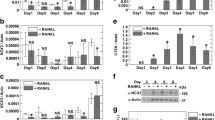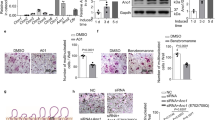Abstract
ClC7 Cl− channels (Clcn7) are crucial for osteoclastic bone resorption and have heterozygous mutation in autosomal osteopetrosis type II (ADO II) patients. Although extracellular acidification is known to induce ClC7 Cl− currents in Clcn7-transfected oocytes, other characteristics of this acid-induced Cl− current, as well as the effects of mutant Clcn7 in ADO II, remain to be determined. The present study showed that extracellular acidification evoked outward Cl− currents in mouse osteoclasts. Expression of wild-type human Clcn7 in HEK293 cells also induced a significant increase in acid-activated Cl− currents. These acid-activated Cl− currents were independent of intracellular acidification and [Ca2+] i increase. HEK293 cells with the Clcn7 mutation associated with ADO II at G215R did not display these Cl− currents. These results suggest that osteoclastic ClC7 Cl− channels are activated under extracellar acidification and suppressed in Clcn7 mutant associated with ADO II during bone resorption.





Similar content being viewed by others
References
Auzanneau C, Thoreau V, Kitzis A (2003) Becq FA novel voltage-dependent chloride current activated by extracellular acidic pH in cultured rat Sertoli cells. J Biol Chem 278:19230–19236
Benichou O, Cleiren E, Gram J, Bollerslev J, de Vernejoul MC, Van Hul W (2001) Mapping of autosomal dominant osteopetrosis type II (Albers-Schönberg disease) to chromosome 16p13.3. Am J Hum Genet 69:647–654
Blair HC, Teitelbaum SL, Ghiselli R, Gluck S (1989) Osteoclastic bone resorption by a polarized vacuolar proton pump. Science 245:855–857
Bollerslev J (1989) Autosomal dominant osteopetrosis: bone metabolism and epidemiological, clinical, and hormonal aspects. Endcr Rev 10:45–67
Brandt S, Jentsch TJ (1995) ClC-6 and ClC-7 are two novel broadly expressed members of the CLC chloride channel family. FEBS Lett 377:15–20
Brockstedt H, Bollerslev J, Melsen F, Mosekilde L (1996) Cortical bone remodeling in autosomal dominant osteopetrosis: a study of two different phenotypes. Bone 18:67–72
Chu K, Snyder R, Econs MJ (2006) Disease status in autosomal dominant osteopetrosis type 2 is determined by osteoclastic properties. J Bone Miner Res 21:1089–1097
Cleiren E, Benuchou O, Van Hul E, Gram J, Bollerslev J, Singer FR, Beaverson K, Aledo A, Whyte WP, Yoneyama T, deVernejoul MC, Van Hul W (2001) Albers-Schönberg disease (autosomal dominant osteopetrosis, type II) results from mutations in the ClCN7 chloride channel gene. Hum Mol Genet 10:2861–2867
Daniels RJ, Peden JF, Lloyd C, Horsley SW, Clark K, Tufarelli C, Kearney L, Buckle VJ, Doggett NA, Flint J, Higgs DR (2001) Sequence, structure and pathology of the fully annotated terminal 2 Mb of the short arm of human chromosome 16. Hum Mol Genet 10:339–352
Diewald L, Rupp J, Dreger M, Hucho F, Gillen C, Nawrath H (2002) Activation by acidic pH of CLC-7 expressed in oocytes from Xenopus laevis. Biochem Biophys Res Commun 291:421–424
Duan D, Winter C, Cowley S, Hume JR, Horowitz B (1997) Molecular identification of a volume-regulated chloride channel. Nature 390:417–421
Dutzler A, Campbell EB, Cadene M, Chait BT, MacKinnon R (2002) X-ray structure of a ClC chloride channel at 3.0 Å reveals the molecular basis of anion selectivity. Nature 415:287–294
Forgac M (1989) Structure and function of vacuolar class of ATP-driven proton pumps. Physiol Rev 69:765–796
Frattini A, Orchard PJ, Sobacchi C, Giliani S, Abinum M, Mattsson JP, Keeling DJ, Andersson AK, Wallbrandt P, Zecca L, Notarangelo LD, Vezzoni P, Villa A (2000) Defects in TCIRG1 subunit of the vacuolar proton pump are responsible for a subset of human autosomal recessive osteopetrosis. Nat Genet 25:343–346
Graves AR, Curran PK, Smith CL, Mindell JA (2008) The Cl-/H+ antiporter ClC-7 is the primary chloride permeation pathway in lysosomes. Nature 453:788–792
Henriksen K, Gram J, Schaller S, Dahl BH, Dziegiel MH, Bollerslev J, Karsdal MA (2004) Characterization of osteoclasts from patients harboring a G215R mutation in ClC-7 causing autosomal dominant osteopetrosis typeII. Am J Pathol 164:1537–1545
Kajiya H, Okamoto F, Li JP, Nakao A, Okabe K (2006) Expression of mouse osteoclast K-Cl co-transporter-1 and its role during bone resorption. J Bone Miner Res 21:984–992
Kasper D, Planells-Cases R, Fuhrmann JC, Scheel O, Zeitz O, Klaus R, Schmitt A, Poet M, Steinfeld R, Schweizer M, Kornak U, Jentsch TJ (2005) Loss of the chloride channel ClC-7 leads to lysosomal storage disease and neurodegeneration. EMBO J 24:1079–1091
Kelly ME, Dixon SJ, Sims SM (1994) Outwardly rectifying chloride current in rabbit osteoclasts is activated by hyposmotic stimulation. J Physiol 475:377–389
Kornak U, Kasper D, Bosl MR, Kaiser E, Schweizer M, Schulz A, Friendrich W, Delling G, Jentsch TJ (2001) Loss of the ClC-7 chloride channel leads to osteopetrosis in mice and man. Cell 104:205–215
Kornak U, Schulz A, Friedrich W, Uhlhaas S, Kremens B, Voit T, Hasan C, Bode U, Jentsch TJ, Kubisch C (2000) Mutations in the a3 subunit of the vacuolar H(+)-ATPase cause infantile malignant osteopetrosis. Hum Mol Genet 9:2059–2063
Lange PF, Wartosch L, Jentsch TJ, Fuhrmann JC (2006) ClC-7 requires Ostm1 as a β-subunit to support bone resorption and lysosomal function. Nature 440:220–223
Ludewig U, Pusch M, Jentsch TJ (1996) Two physically distinct pores in the dimeric ClC-0 chloride channel. Nature 383:340–343
Okamoto F, Kajiya H, Fukushima H, Jimi E, Okabe K (2004) Prostaglandin E2 activates outwardly rectifying Cl- channels via a cAMP-dependent pathway and reduces cell motility in rat osteoclasts. Am J Physiol Cell Physiol 287:C114–C124
Picollo A (2005) Pusch M (2005) chloride/proton antiporter activity of mammalian CLC proteins ClC-4 and ClC-5. Nature 436:420–423
Reddy SV, Devlin RD, Menna C, Nishumura R, Choi SJ, Yoneda T, Roodman GD (1998) Isolation and characterization of a cDNA clone encoding a novel peptide (OSF) that enhances osteoclast formation and bone resorption. J Cell Physiol 177:636–645
Schaller S, Henriksen K, Sveigaard C, Heegaard AM, Helix N, Stahlhut M, Ovejero MC, Johansen JV, Solberg H, Andersen TL, Hougaard D, Berryman M, Shiϕdt CB, Sϕrensen BH, Lichtenberg J, Christophersen P, Foged NT, Delaisse JM, Engsig MT, Karsdal MA (2004) The chloride channel inhibitor NS3736 prevents bone resorption in ovariectomized rats without changing bone formation. J Bone Miner Res 19:1144–1153
Schmidt-Rose T, Jentsch TJ (1997) Transmembrane topology of a CLC chloride channel. Proc Natl Acad Sci U S A 94:7633–7638
Semba I, Ishigami T, Sugihara K, Kitano M (2000) Higher osteoclastic demineralization and highly mineralized cement lines with osteocalcin deposition in a mandibular cortical bone of autosomal dominant osteopetrosis type II: ultrastructural and undecalcified histological investigations. Bone 27:389–395
Silver IA, Murrills RJ, Etherington DJ (1988) Microelectrode studies on the acid microenvironment beneath adherent macrophages and osteoclasts. Exp Cell Res 175:266–276
Takahashi N, Yamada H, Yoshiki S, Roodman GD, Mundy GR, Jones SJ, Boyde A, Suda T (1988) Osteoclasts-like cell formation and its regulation by osteotropic hormones in mouse bone marrow cultures. Endocrinology 122:1373–1382
Tezuka K, Sato T, Kamioka H, Nijiweide PJ, Tanaka K, Matsuo T, Ohta M, Kirihara N, Hakeda Y, Kumegawa M (1992) Identification of osteopontin in isolated rabbit osteoclasts. Biochem Biophys Res Commun 186:911–917
Waguespack SG, Hui SL, White KE, Buckwalter KA, Econs MJ (2002) Measurement of tartrate-resistant acid phosphatase and the brain isoenzyme of creatine kinase accurately diagnoses type II autosomal dominant osteopetrosis but does not identify gene carriers. J Clin Endocrinol Metab 87:2212–2217
Wang GX, Hatton WJ, Wang GL, Zhong J, Yamboliev I, Duan D, Hume JR (2003) Functional effects of novel anti-ClC-3 antibodies on native volume-sensitive osmolyte and anion channels in cardiac and smooth muscle cells. Am J Physiol Heart Circ Physiol 285:H1453–H1463
Yamamoto S, Ehara T (2006) Acidic extracellular pH-activated outwardly rectifying chloride current in mammalian myocytes. Am J Physiol Heart Circ Physiol 290:H1905–H1914
Acknowledgements
We would like to thank Dr. S.V. Reddy for the gift of human osteoclast cDNA library and his valuable comments. We would also like to thank Dr. Andreas Carl and Jeremy Williams for editing the English of this manuscript.
Grants
This work was supported by a Grant-in-Aid for Scientific Research from the Ministry of Education, Culture, Sports, Science, and Technology of Japan (No. 17591957 and 19592165) and a Frontier Research Grant.
Conflicts of interest
The authors have no conflict of interest.
Author information
Authors and Affiliations
Corresponding author
Rights and permissions
About this article
Cite this article
Kajiya, H., Okamoto, F., Ohgi, K. et al. Characteristics of ClC7 Cl− channels and their inhibition in mutant (G215R) associated with autosomal dominant osteopetrosis type II in native osteoclasts and hClcn7 gene-expressing cells. Pflugers Arch - Eur J Physiol 458, 1049–1059 (2009). https://doi.org/10.1007/s00424-009-0689-4
Received:
Accepted:
Published:
Issue Date:
DOI: https://doi.org/10.1007/s00424-009-0689-4




